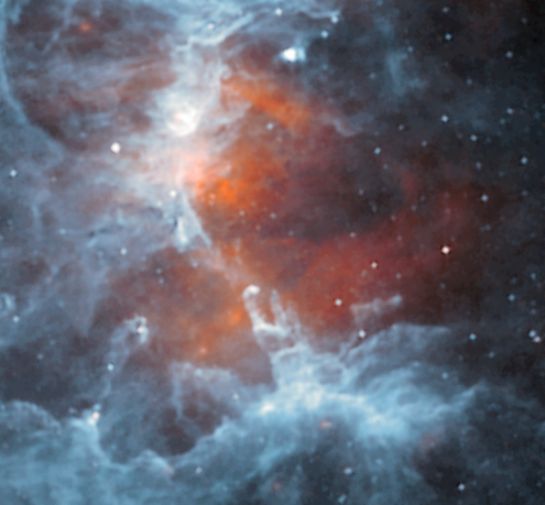Explanation: Stars are born in M16's Eagle Nebula, a stellar nursery 7,000 light-years from Earth toward the constellation Serpens. The striking nebula's star forming pillars of gas and dust are familiar to astronomers from images at visible wavelengths, but this false-color picture shows off the nebula in infrared light. Data from ESA's Infrared Space Observatory satellite (ISO) was used to construct the detailed two color image, dominated by infrared emission from clouds of interstellar material at temperatures below -100 degrees Celsius. Blue colors highlight emission thought to indicate the presence of complex carbon molecules, known on planet Earth as PAHs, while red colors trace emission from cold, microscopic dust grains. Hot young stars are formed as this frigid material condenses under the influence of gravity. Once begun, the process takes only tens of thousands of years for truly massive stars and up to tens of millions of years for low mass stars like the Sun.
1998 1999 2000 2001 2002 2003 2004 2005 2006 2007 2008 2009 2010 2011 2012 2013 2014 2015 2016 2017 2018 2019 2020 2021 2022 2023 2024 |
Январь Февраль Март Апрель Май Июнь Июль Август Сентябрь Октябрь Ноябрь Декабрь |
NASA Web Site Statements, Warnings, and Disclaimers
NASA Official: Jay Norris. Specific rights apply.
A service of: LHEA at NASA / GSFC
& Michigan Tech. U.
|
Публикации с ключевыми словами:
инфракрасное излучение - PAHs - dust - infrared - Eagle Nebula - M 16 - Туманность Орла - звездная пыль - молекулы - межзвездные молекулы - molecules
Публикации со словами: инфракрасное излучение - PAHs - dust - infrared - Eagle Nebula - M 16 - Туманность Орла - звездная пыль - молекулы - межзвездные молекулы - molecules | |
См. также:
Все публикации на ту же тему >> | |
